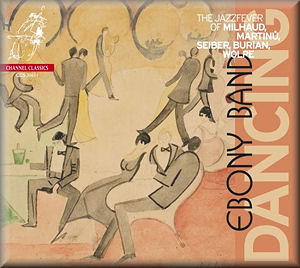 |
 |
|


alternatively
CD: MDT
AmazonUK
AmazonUS
|
Dancing
Stefan WOLPE (1902-1972)
Suite from the Twenties [14:23]
Emil František BURIAN (1904-1959)
Suite Americaine, Op.15 (1926) [11:21]
Bohuslav MARTINŮ
(1890-1959)
Jazz Suite (1928) [11:25]
Mátyás SEIBER (1905-1960)
Jazzolette No.1 (1929) [3:15]
Jazzolette No.2 (1932) [4:01]
Darius MILHAUD (1892-1974)
La création du monde, Op.81 (1923) [16:47]
 Ebony Band/Werner Herbers
Ebony Band/Werner Herbers
rec. 14 April 2007, Toonzaal, Den Bosch (Wolpe); 21 May 2007, De
Vereeniging, Nijmegen (Milhaud); 27 April 2011 (Burian & Martinů),
and 1 July 2011 (Martinu), Muziekgebouw aan ’t IJ, Amsterdam; 4
December 2001, Doopsgezinde Singelkerk, Amsterdam (Seiber).
 CHANNEL CLASSICS CCS 30611 [61:25]
CHANNEL CLASSICS CCS 30611 [61:25] 
|
|
|
The Ebony Band is back, this time with a jazz programme containing
known and less familiar pieces recorded at recent live performances.
Packaged in a nicely designed foldout sleeve and with a booklet
richly illustrated with period dance-themed artworks and portraits
of the composers, this is one of those releases with a vibe
of anticipation to which you know in advance the contents of
the disc will be more than equal.
Berlin-born and bred, Stephan Wolpe’s Suite from the Twenties
dramatically links atonal modernist musical tendencies with
jazz style. Geert van Keulen’s distinctive instrumentation heightens
this sometimes grotesquely theatrical effect in six punchy movements,
taking the music beyond what were originally pieces for piano
into a kind of distortion of the dance hall. This is a marvellous
piece, filled with striking and compact directness of expression.
Stravinsky-like syncopations can be heard in the opening Tango
for Irma, there is perhaps something of Kurt Weill’s declamatory
style in the Marsch nr.1, and the spirit of Webern seems
to inhabit the tonal and timbral pointillism of Tanz (Charleston).
Emil Burian was a pupil of Suk and Foerster, working for cabaret
theatres and promoting contemporary music as well as composing.
His Suite Americaine is distinctive not least for its
prominent part for the violophone, a violin whose strings are
amplified via a horn rather than the wood of a soundboard. This
strange sound floats above the band like a soloist whose part
is being sent in via radio relay and projected through an old
gramophone player. The music itself is the composer’s sophisticated
take on dance numbers like the Charlstonette (Foxtrott) and
a Valse Boston. The spooky nature of the instrumentation
is heavily in evidence in the restrained Tango Argentino,
and the final Fuga-Fox is a miniature tour de force on
the initials of the composer’s own name.
Bohuslav Martinů’s Jazz Suite has appeared a few
times in recordings, and I first came across it via a Supraphon
LP recording which can now be found on CD on a release titled
‘Works Inspired by Jazz and Sport.’ The Ebony Band’s performance
is every bit as idiomatic as the Prague players, and with more
soulful atmosphere in the Blues. The strings are more
prominent in the mix, and accompanying ostinati and sustained
notes intrude perhaps a bit much here and there, but this is
still a cracking recording. It has plenty of that loungy salon
atmosphere in the Boston and all of those subtly swinging
rhythms perfectly placed throughout, and notably in the rousing
Finale.
The Hungarian Mátyás Seiber is perhaps best known for film scores
such as that for the 1954 animated version of George Orwell’s
Animal Farm. The two Jazzolettes cross witty wah-wah
playing with Second Viennese School compositional techniques
– the second of the pieces starting with a 12-note row in the
trumpet. This is a remarkable pair of works: brief and intense,
but full of superb invention and a gasping sense of ‘how does
he do that?’
There can be little doubt that Darius Milhaud’s La création
du monde is the best known work here, and by chance I recently
had the privilege of reviewing the composer’s own conducted
recording on the André Charlin label, SLC 17. The Ebony Band
is a better bunch of players than the orchestra Milhaud worked
with in 1956, but it’s always fascinating to hear a composer’s
own rendition of his work. The timings between the versions
differs by 20 seconds, and therefore as close as makes no difference.
Werner Herbers creates an almost menacing atmosphere in the
opening pages, with heavy drums and emphasising the darker side
of the harmonies, as well as providing a fruitily warm bed of
sonority for the saxophone solo. This is a work for ballet,
so fits in with the ‘dance’ theme of this album while differing
in its lack of direct reference to dancehall numbers. As African
‘primitivism’ had already hit Paris and Picasso’s fascination
with African masks had been launched in previous years, so was
Milhaud enthralled by the black operettas he saw in New York,
integrating their fashionable American orchestration into the
story of creation as taken from African mythology. This is a
terrific piece and a marvellous performance – art and music
united in sound.
You may or may not know it, but we all really need the Ebony
Band. Werner Herbers’ crusade to make us aware of forgotten
composers and neglected repertoire has already brought us Józef
Koffler and Konstanty Regamy (see review),
Weill, Toch and Schulhoff (see review)
and many more, and once you’ve widened your horizons with these
kinds of programmes you will wonder why everyone else seems
so keen to re-record mainstream warhorses over and over again.
This Dancing – The Jazzfever of… release is taken from
live recordings at various locations, but there are no discomfortingly
extreme changes of recorded perspective, and applause and audience
noise is absent. We’ve had popular ‘jazz’ discs before now –
the kind like Simon Rattle’s London Sinfonietta EMI release
way back in 1987, which always sell out in advance of Christmas
and have shop owners tearing their hair out wishing they’d ordered
more. Let’s hope this Ebony Band achieves the same kind of commercial
success – it most certainly deserves it.
Dominy Clements
|
|

